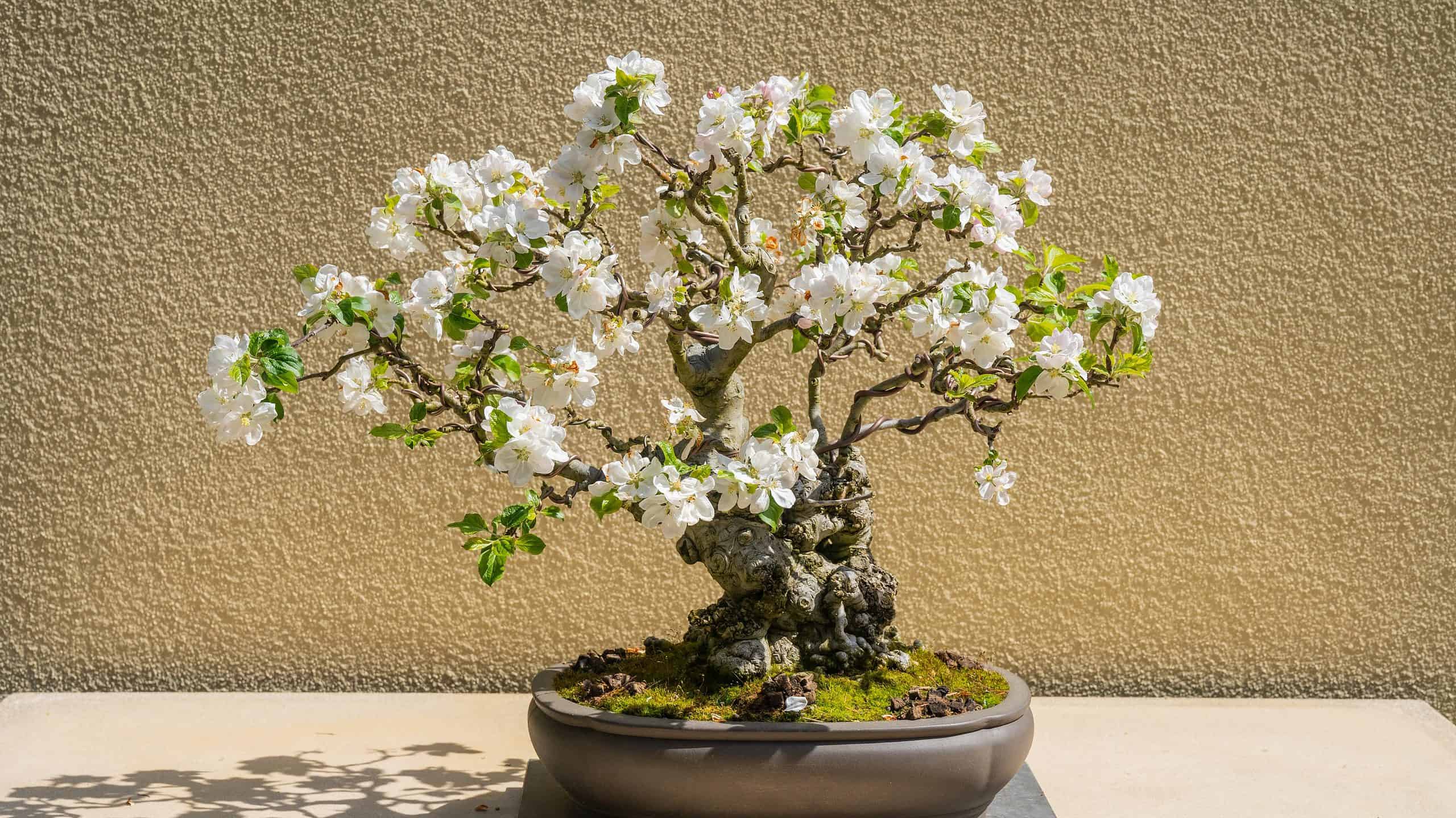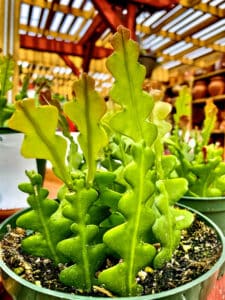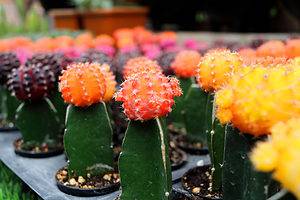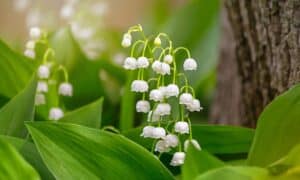While many of us might think of bonsai as specific species like a spruce or fir tree, apple trees actually make incredibly beautiful bonsai that most enthusiasts can grow, even without much experience. The tree is beautiful, easily styled, and moderately easy to care for, and they are available all over the world without special stores, supplies, and skills needed to get started.
Let’s take a look at these incredible fruiting trees and see if they might be the right bonsai for you.
What Makes Apple Trees Good for Bonsai?

They’re fast-growing and beautiful, even if they take a while to fruit.
©Raquel Pedrosa/Shutterstock.com
Apples make for excellent bonsai trees for a number of reasons.
- They’re affordable and easy to find
- They’re easier to care for than many species
- They grow via seed or cutting
- They thrive outdoors
- Any species of apple may be grown as bonsai
- They’re fast growers
- They have dense foliage, making them excellent ornamental plants
- They’re easily trained
- They live for many years
Apple Tree Classification

Apple bonsai produce incredibly beautiful fruit and leaves.
©Real Moment/Shutterstock.com
Apple trees belong to the genus Malus. The variety or species will attach other names to this general name, such as Malus domestica, the common apple tree that most of us think of as apples. The genus contains around 50 species, with hundreds of varieties and something like 7,500 known cultivars.
Apple Bonsai Description
Apple trees come in a variety of looks, coloration, and visuals because there are literally hundreds of varieties at over 4 dozen species. This means giving a precise description of apple bonsai is challenging. However, there are some characteristics to be aware of.
Flowers
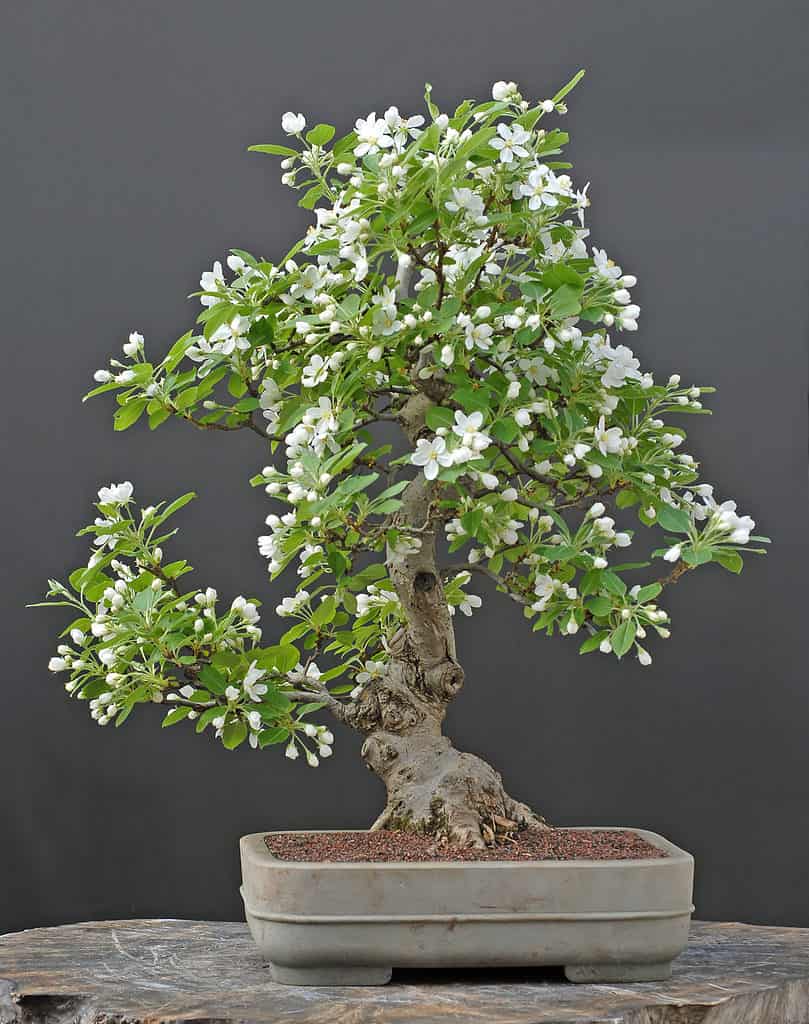
Apple bonsai in full bloom
©Walter Pall/Shutterstock.com
For one, most apple species produce slightly pinkish white flowers. They often are all white with pink centers or the flowers themselves have a pinkish hue to them. Some of the flowers may be deeper in color, particularly ornamental apple species, developing into red blooms when mature.
The flowers tend to be abundant on healthy plants, often to the point that the branches and leaves are nearly invisible.
Aroma
Apple blossoms also produce sweet, heady aromas that you can smell from a fair distance off.
Fruit
Apple trees, even ornamentals in some case, bear plenty of fruit when the plants are healthy and provided with proper nutrients, water, and light. The fruits on bonsai are typically very small, between 0.4 and 0.8 inches in size.
Most bonsai species produce red fruit, though some will produce yellow apples.
Roots
Bonsai apple roots tend to be thick and strong, as well as plentiful. The trees are hardy, fast growers, meaning they really plant themselves with strong roots. Because of this, many bonsai growers trim the roots annually.
Bark
Apple bark is usually smooth, almost sleek. The bark injures easily, as well, so it’s important to protect it during wiring.
Origins and History of Apple Trees

Apples are seen as American, but they’re not native to North America.
©Paul Hardwick Images/Shutterstock.com
While many of us think of apples as distinctly American (read: apple pie!), the tree actually is not native to North America. The apple is actually from central Asia, around Kazakhstan, near the Caspian Sea. The capital of Kazakhstan, Alma Ata, actually means “full of apples.” Seeds from the tree had been exported throughout the European region by 1500 BC, with the Greeks, Etruscans, and Romans all cultivating the tree by this period, and ultimately the seeds were brought to the British Isles by the Romans. There is evidence of the apple tree in the Paleolithic era among food gathering peoples of Kazakhstan, with evidence of apples depicted in artwork and records from many eras, including 1300 BC with Egyptians growing them along the Nile Delta, 800 BC Greeks grafting them, 200 BC Roman orchards in Britain, and 1500s to 1600s with Spaniards bringing them to the Americas.
Varieties of Apple Bonsai
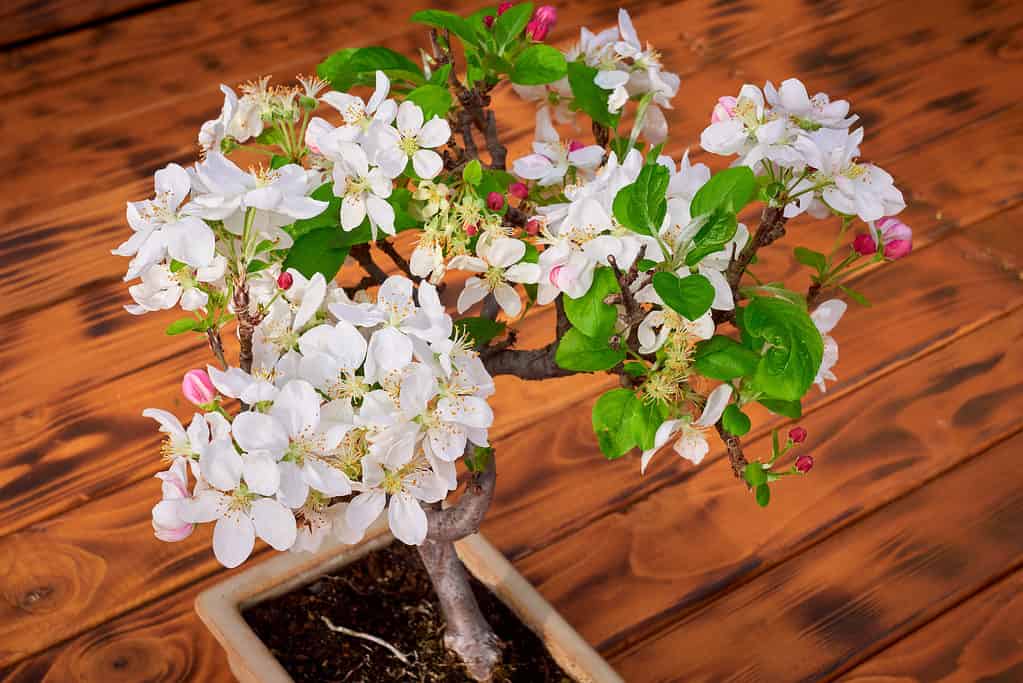
The trees produce loads of flowers and fruit.
©Adrian Eugen Ciobaniuc/Shutterstock.com
Technically, any species or variety of apple tree may be used in the bonsai trade. With over 50 species and hundreds of varieties, that’s a lot to sort through! However, some are more favored for their foliage, fruits, or flower colors and may be more suitable for bonsai than others. Some of the most popular and most often recommended apple species and varieties for bonsai include:
- Malus ‘Crimson Brilliant’
- Malus Liset
- Malus Nicoline
- Malus Eleyi
- Malus halliana, or Hall’s apple
- Malus floribunda, or Coral apple, Japanese apple
- Malus toringo, or Japanese mountain apple
- Malus sylvestris, or crab apple or wild apple
How to Grow Apple Bonsai
Apple bonsai are one of the less expensive, more common to find, easier to grow bonsai species around. You don’t need particularly fancy species or expensive equipment, either, despite many of the misunderstandings about the art.
And while there are specific species of apples most recommended for the art of bonsai, pretty much any species can technically be grown as such. They’re also available globally, year-round in the form of seeds and often in established plant form.
The main thing is that they need lots of water and decent sunlight.
Planting Location
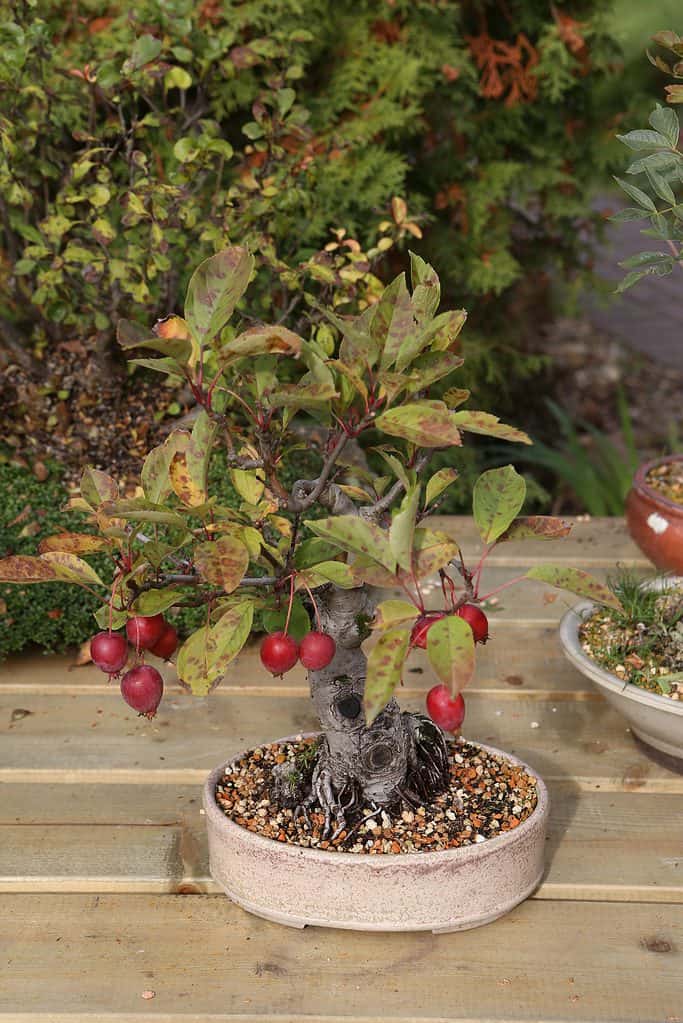
The tree does best outdoors.
©Sergey Bezgodov/Shutterstock.com
Apple bonsai really should be kept outdoors only, save in more extreme environments or particularly wet seasons. They should be sheltered in rainy climates and placed where they will receive up to 6 hours of sunlight per day in hotter weather. They do tolerate higher winds, but only when properly established.
Soil
Apple bonsai require high organic content in their soil, which must be well-draining. Many folks choose mix one part peat, one part sand, and two parts loam for this planting mixture. Be sure to lightly moisten the soil mix before planting seedlings or prepared cuttings.
You may also purchase premade bonsai potting mixes for planting your bonsai.
Lighting
Apples need direct sunlight for about 6 hours per day during spring and summer, with partial shade in the hottest months.
Temperature
Apple bonsai do between in temperatures between 40 and 90 F, though they can survive much colder temperatures in winter (down to -4 F) for shorter periods. Protect the roots with mulch when temperatures drop below 40 F consistently.
Watering
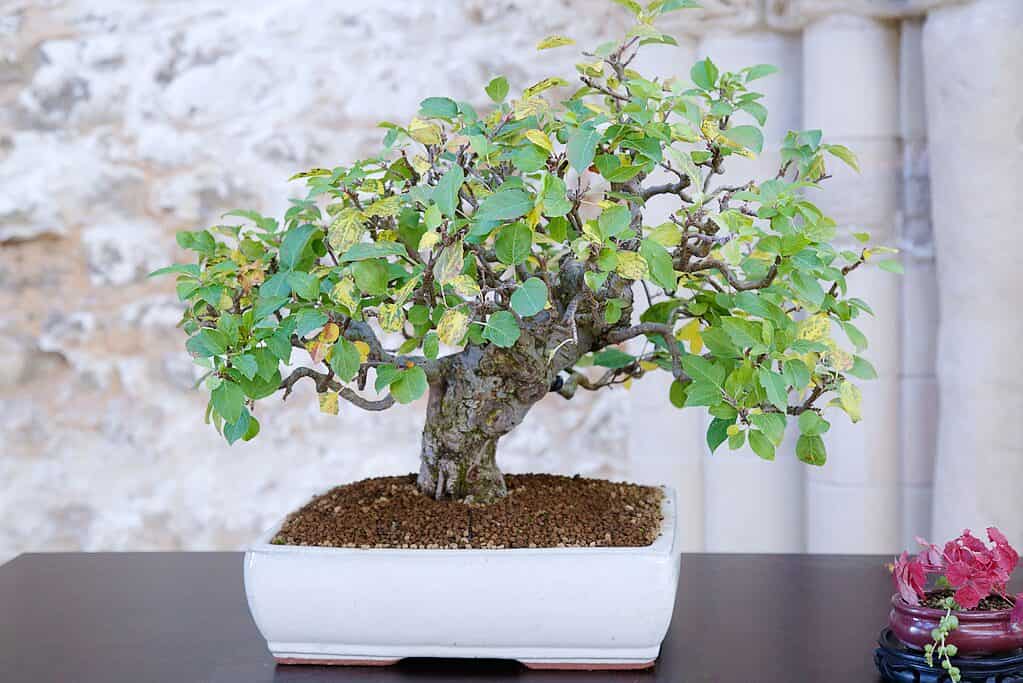
Apples come in many varieties and can be shaped in numerous ways.
©Raquel Pedrosa/Shutterstock.com
Apple trees are thirsty plants, so be sure to offer them plenty of fluids all summer long, especially as they near and enter fruiting season. They can tolerate the occasional drying out, but they don’t tolerate them well and shouldn’t have that happen often.
When the flowers and fruit are on the tree, avoid pouring water over the plant and instead focus on watering just the soil. The water may disrupt pollination or fruiting.
In the springtime, water the plant once daily if the soil is dry to the touch, and water several times a day in hotter weather.
It’s best to keep apple bonsai in moisture trays or shallow bowls of water to keep the plant moist and healthy.
Finally, in winter, water the tree about once per week.
Feeding

They thrive outdoors in sunlight for 6 hours.
©mindfullness/Shutterstock.com
Apple bonsai do best with lower nitrogen fertilizer, whatever form you use (liquid or granular). Higher nitrogen produces more plant growth but less fruit, however, so choose according to your needs.
With higher nitrogen, the plant may grow up to three feet in a single year, depending on pot size. With lower nitrogen, the plant will produce more blooms and still grow but more like a foot in a year. A balanced fertilizer is better for “average” growth of both. Many of the commercially available liquid bonsai fertilizers are perfect for this.
Some bonsai enthusiasts recommend that during summer, fertilizing twice as often as indicated on the bottle will improve the bonsai’s life and growth.
Fertilize with organic fertilizer once every 6 weeks. Liquid fertilizer can also be used, however, aim for lower nitrogen levels which will cause the tree to grow as opposed to the fruit.
Pruning
Apple trees are fast growers, which makes them a popular choice for newer bonsai enthusiasts. This also means they require pruning more frequently, particularly when they are young. The shoots are often trimmed in both summertime and the resting phase.
Apple blooms pop out on the shorter shoots from June to July, so be sure to prune the short shoots earlier in the season than later to avoid cutting off blooms the next year/growing season.
To prune, use a sharp bonsai concave cutter or knob cutter. Bonsai scissors aren’t typically strong enough to prune the thick apple branches.
Shaping

They may be shaped in almost any bonsai style.
©Sergio Arjona/Shutterstock.com
Apples have soft, pliable branches, which make them excellent candidates for wiring. This also means that nearly all bonsai styles are possible for apples. They’re typically designed as informal upright or slight inclines, however, as well as cascades, semi-cascades, double or twin trunks, and broom shapes.
You can even – with some skill and study – grow apple bonsai as over-rock style. Be sure the rock is the right size to meet the size of the plant, however, as too large a rock will cause issues and too small a rock will be overgrown by the roots.
Wiring
Apple bonsai branches tend to be soft and so take to wiring very easily. If you were to remove wire, you would likely notice the branches return to their original and natural shape fairly quickly. It’s best to keep the wiring in place for as long as possible to maintain the bonsai shaping.
You should wire the apple in early summer (northern hemisphere between May and June), when the plant has its thickest leaves and freshest growth before apples start to form. This enables the wire to properly support the branches and maintain the shape when the apples do form.
Defoliate, as needed, to allow proper wiring.
Apple Bonsai Wiring Tips:
- Avoid copper wiring
- Use aluminum wire
Re-Potting
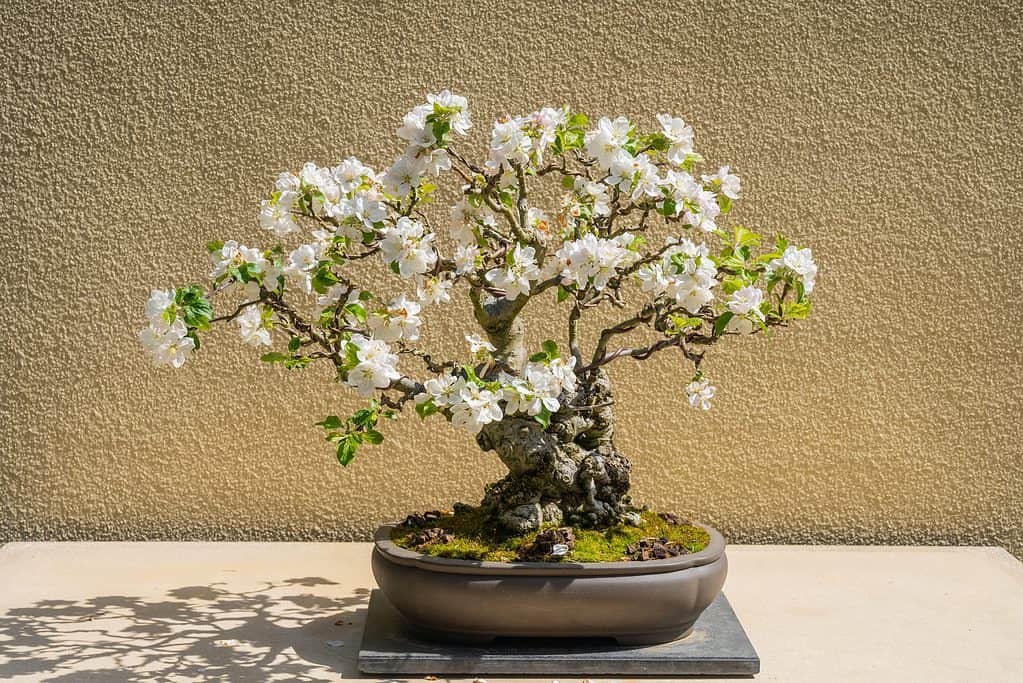
It’s recommended that you re-pot young bonsai every year.
©Mariusz S. Jurgielewicz/Shutterstock.com
Apple bonsai typically need to be re-potted once annually in the springtime. Ideally, this will be done in March in the Northern hemisphere, as early spring hits and frosts begin to dissipate.
Ensure the new pot has proper drainage and healthy soil mixed in with loose substrates.
Prune as needed (this is a great time for cuttings for growing more apple bonsai!) and remove any necessary extra rooting. Some folks remove approximately one-third of the roots each year to help keep the plant healthy and contained in its smaller bonsai size.
Overwintering
Apple bonsai are thankfully very hardy trees. Think about those apple orchards – just translate to smaller forms in containers! Apple trees may endure temperatures down to -4 F without frost damage. If your climate typically gets colder than this, you may need to move the bonsai into a greenhouse or indoors during the coldest months.
Apple bonsai may sunk into garden soil during fall, as well, in a sheltered, shady area, to help protect against the winter. The danger with this is mice who tend to nibble on apple bark during winter months.
Check the tree regularly throughout the winter for signs of frost, animal, or weather damage. If you spot anything out of the ordinary, you will want to move it into a more sheltered or warmer environment.
Common Problems of Apple Bonsai
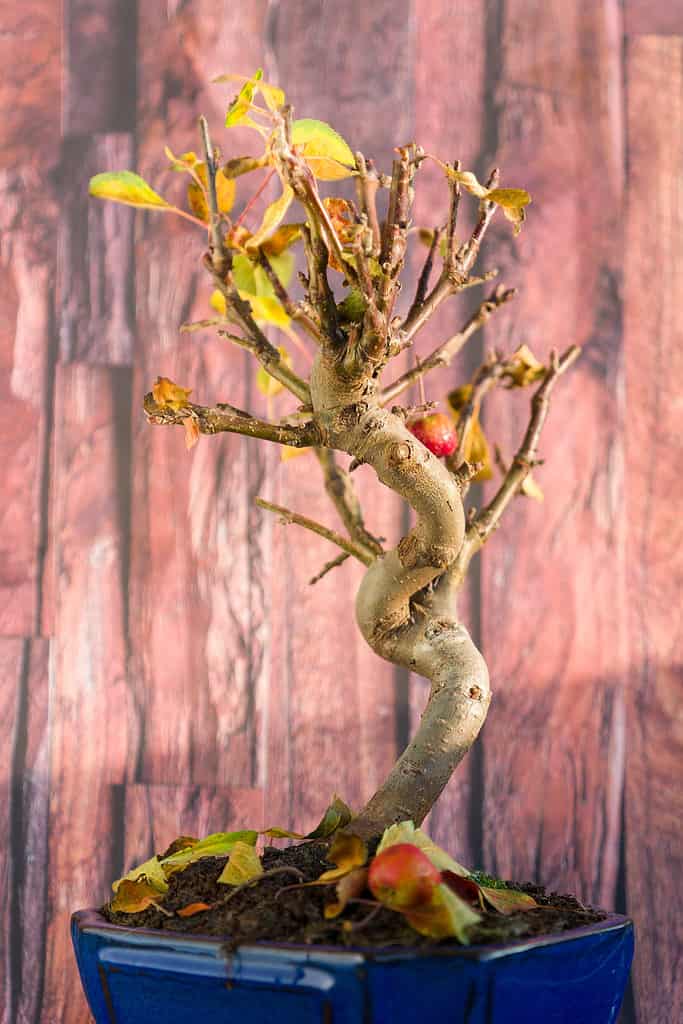
They require care year-round, even in winter.
©Fernando Gabino/Shutterstock.com
Mildew
The most common issue with apple bonsai is mildew. This often occurs because the seeds or plant from which the cuttings come from have been mildewed previously or the plant is overly moistened and in too high humidity.
Dealing with mildew is thankfully fairly easy: use a commercial sulfur or copper fungicide sprays intended for apple trees combating mildew.
Aphids
The second most common issue with apple bonsai is aphid infestation. This typically occurs with nitrogen-rich soil during growing season.
To combat aphids, purchase and use aphid sprays as directed. You should only need this treatment once annually.
How to Propagate Apple Bonsai
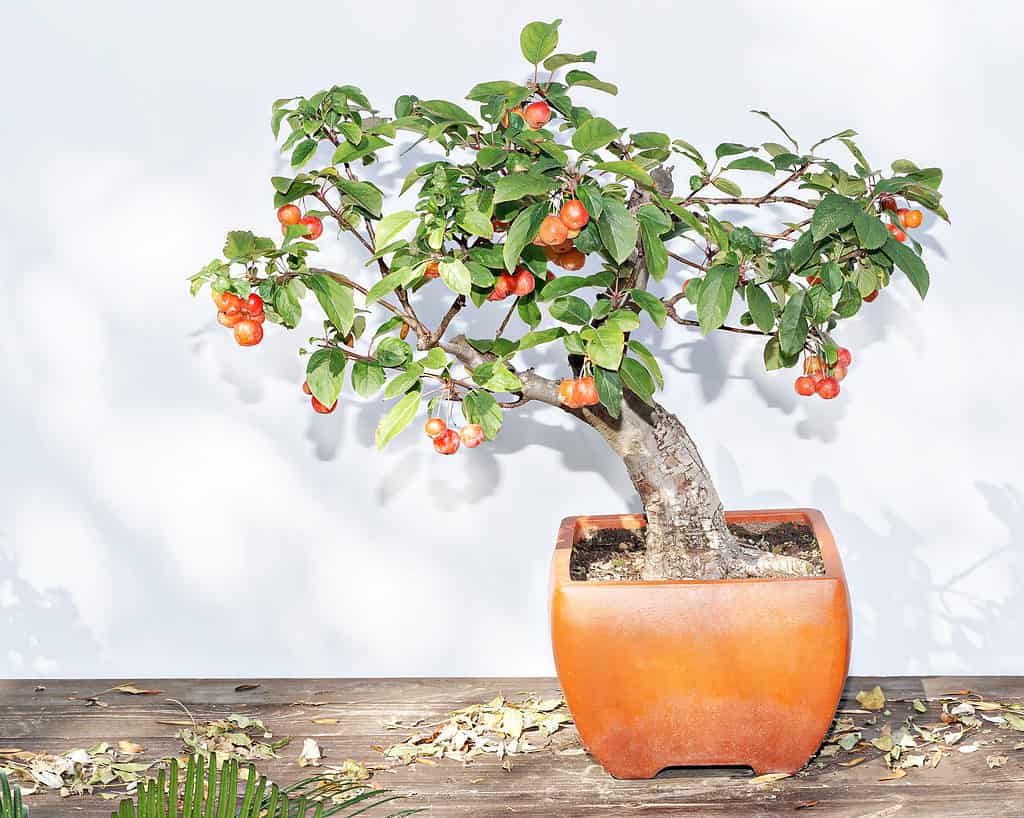
They may be grown from seeds or cuttings.
©mindfullness/Shutterstock.com
Many folks propagate their apple bonsai from seeds because it’s one of the easiest bonsai to grow this way.
To grow your own bonsai from seeds:
- Research the species of apple you wish to grow as a bonsai and purchase fresh, raw apple seeds that have not dried out.
- Using damp sand, stratify the seeds for 2 to 3 months in the refrigerator at 39 to 42 F.
- Keep the sand damp but not soggy.
- Seedlings will emerge around this time.
- Once seedlings are established, transplant into the bonsai pots and care for as directed for the trees.
You may also propagate an apple bonsai tree from cuttings. To do this, you’ll need to get cuttings from the species of apple tree you want to grow. Be sure the mother plant is healthy and has the properties you want, as these will be reflected in your bonsai.
- When you have healthy cuttings, store them, cut end downward, in moist vermiculite or sawdust for 3 to 4 weeks.
- Place the cuttings in a cool cellar or basement, refrigerator, or controlled temperature room.
- After the chilling period, note if calluses have formed at the cut end. If they have not, continue chilling for another week or two.
- Dust the callused ends with rooting powder and plant into a container of moist peat soil.
- When the plant has taken root, transfer the plant into the bonsai pot and care for as directed above.
Apple Bonsai FAQs
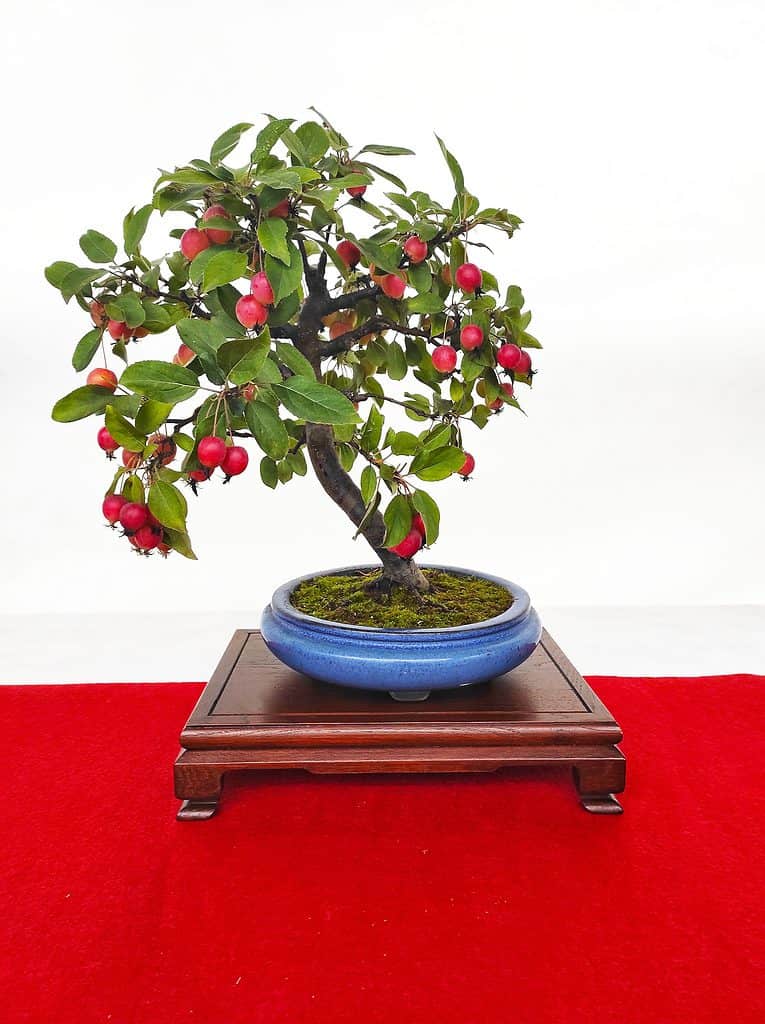
They thrive outdoors but when cared for properly make for gorgeous indoor plants as well.
©Hanicka1982/Shutterstock.com
Can you eat apples from a bonsai tree?
It’s important not to damage the tree when harvesting, but yes, you can safely eat the apples from an apple bonsai. Pick the fruit immediately when it reaches maturity and eat right away for best results.
Even if you don’t plan to eat the apples, it’s best to pick the fruit upon full ripeness to avoid attracting pests and insects that may damage the tree.
How long do apple bonsai trees take to grow?
A typical apple bonsai tree takes between three and five years to reach its full size. Special and crafted care, however, can speed up this timeline a bit, when properly applied. All in all, though, even with this high level of care, it will still take at least three years for apple bonsais to reach their potential.
Up Next:
Thank you for reading! Have some feedback for us? Contact the AZ Animals editorial team.

